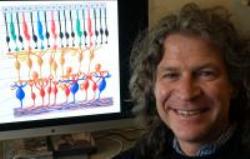A University of Oregon research team led by Richard Taylor is designing nanoflowers that will enable blind people including those afflicted by macular degeneration to regain vision.
The nanoflowers will be fabricated from metal nano-particles that grow or naturally arrange themselves by a technique called diffusion limited aggregation. These are also known as fractals and will effectively simulate and interact with neurons.
 Uregon's Ricard Taylor with the metallic nanoflowers
Uregon's Ricard Taylor with the metallic nanoflowers
According to Taylor, the fractals are building blocks of nature and contain irregular curves or structures, one component, of which will also reveal the same shape or structure when viewed through a magnifying glass. This property in mathematics is known as self-similarity. Fractals include trees, clouds, rivers, galaxies, lungs and neurons but electronic chips are not fractals.
Eye surgeons could insert these fractal models in the eyes of blind people, imparting interface circuitry to direct light acquired by the retina with 100% efficiency to neurons that would communicate with the optic nerve to provide vision.
The research paper titled, ‘Vision of beauty,’ released recently in Physics World, has been authored by Taylor, a physicist and director of the UO Materials Science Institute. The paper describes the experiment and how current problems with photodiodes insertion behind the eyes can be solved. Existing chip technology does not allow enough contact with neurons. The neurons in the retina are fractals, whereas the chips are not. They are nano squares of electrodes that offer minimum overlap with neurons.
Rick Montgomery, post doctoral student with Taylor will team up with Simon Brown at the University of Canterbury in New Zealand to study how different metals can be used to culture the fractal flowers on chips that can be implanted into the eyes.
Source: http://uoregon.edu